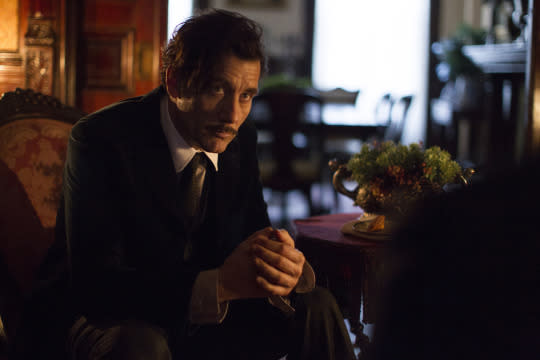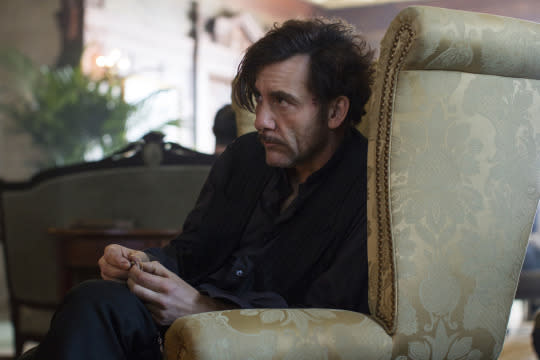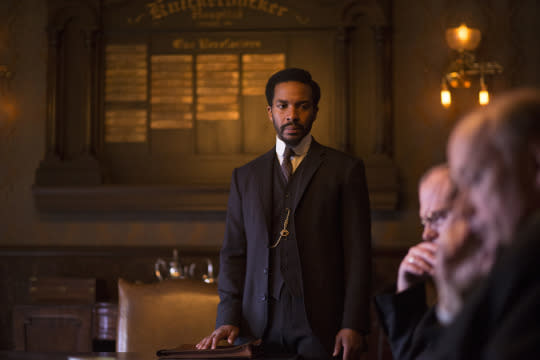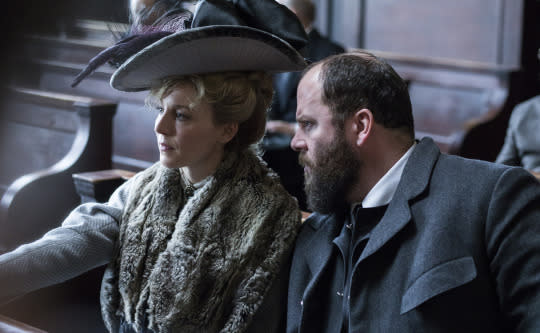'The Knick' Season 2 Preview: Dr. Thackery's New Addiction — and a 'Walking Dead' Addition

The freshman season of Cinemax’s The Knick was a knockout, both visually and dramatically, with Clive Owen starring as Dr. John Thackery, the drug-addled chief surgeon of a cash-strapped hospital in 1900 New York. It managed to be both repulsive, with stomach-churning surgery scenes where very few patients survived, and mesmerizing, with beautiful candlelit scenes shot by Oscar-winning director Steven Soderbergh. But what can it do for an encore?
“We paint it on a bigger canvas, but with a finer brush,” co-creator Jack Amiel tells Yahoo TV about Season 2 of The Knick, debuting this week. “If last year was about being subjugated and being at the whim of a society that was either sexist or racist or classist, I think this year is about doing something about it… Whether or not it’s successful is another thing.”
Related: ‘The Knick’ Season 2 Trailer: Thackery’s on a Boat… and on Heroin
We asked Amiel and co-creator Michael Begler to give us the scoop on Dr. Thackery’s status after he hit rock bottom last season; how new cast addition Emily Kinney, of The Walking Dead fame, fits into the show; and how much influence Soderbergh has on The Knick’s unique visual style.
Last we saw Dr. Thackery, doctors were giving him heroin to treat his cocaine addiction. Does that change his personality at all?
Begler: We’re not gonna find him in a good place. The show takes place a month later, so he’s still gonna be at Cromartie, which is the name of the hospital. We’re gonna see him in a pretty desperate state, because now it’s not just about a cocaine addiction; it’s about a heroin addiction. So this definitely, at least in the beginning, will shift his personality. And you’ll see that very quickly in Episode 1. He’s gonna be more manic, more paranoid. Everything we left him with has only gone downhill.
Amiel: What we want to stress is how little people understood addiction. Today, we’re still struggling with addiction and how it affects people. We’re having sporadic success with addiction treatment. So imagine a hundred years ago, when no one understood it. That’s what we want to explore: a time when people were desperate, and yet there were no resources to help them.

We also saw last season that the board voted to shut down the Knick. Does Thackery even have a hospital to go back to?
Begler: The Knick is still open, but what they’re doing is they’re gonna build a new one. So they’re breaking ground for the new uptown hospital, but they’re gonna keep the old Knick functioning until then. But the money and the resources are now being allocated to the new place, so the hospital, which is already not doing well, is doing even worse because of it.
Amiel: It hasn’t been built yet, but the whole goal is to go where the money is, and where the paying patients are. Downtown, they’re flooded with people who actually need them. But those people can’t pay. And it’s been taking a toll on the hospital’s finances. So they’ve been rushing uptown like so many other hospitals, to where there’s money and space and land and wealthy benefactors who will help them build.
And is Algernon okay? Because last we saw him, he was left bleeding on the ground after another bar fight.
Begler: I think some people thought he was dead. No, he took a serious beating, but he’s back. There’s gonna be consequences to all that as well; all that fighting is gonna have an effect on him. Also, when we meet him, he’s the surgeon in charge of the hospital, because Thackery is away. It’s a little about that, how he is seen through the eyes of the board, and what he wants to accomplish. In his mind, he doesn’t know, if Thackery is in such a state, if he’ll ever come back. And so this is his chance to get what he wants, and what he thinks he deserves, which is to be the chief of surgery. But the obstacles for that are so great, just because of the color of the skin.

Emily Kinney from The Walking Dead joins the cast this season. What can you tell us about her character?
Amiel: She plays Daisy Ryan. She plays an impressionable young nurse, who, because she’s pretty, catches the eye of a wealthy young man. And what we watch is whether the charms of a wealthy young man in this era can get what he wants from her. How modest are the woman of this era? And she’s sort of a new litmus test for that.
We see shots in the trailer of a quarantine in San Francisco. So is part of this season taking place there as well?
Begler: Yeah, because when we last left Cornelia, she was heading back there to go with Philip. So that’s where we sort of begin with her. And that quarantine is actually based on a real outbreak, a plague, that was going on in San Francisco at the time.
Amiel: Yeah, we wanted to broaden the show out. We spent a lot of time on location this season. We were incredibly grateful to be able to go to many incredible locations that give the show not only a larger field, but such an authentic feel. And so it really does get much bigger and goes further afield, and we decentralize a little bit from the hospital. But at the same time, what we do is drill much deeper on a lot of the characters and who they are. And that was a really great luxury.
The look of this show is very distinctive: the natural light, the handheld cameras. Did that come from Steven Soderbergh, or did you guys have that in mind when you pitched the show?
Begler: No, it was one hundred percent Steven. We wrote the pilot on spec, and Steven read it and loved it, and we broke out the ten episodes with him. But the look and the feel and the music… that’s all from the gigantic brain of Steven. You will see that nothing stays the same for this guy. So the look of this year is wildly different than the first season. That was sort of the challenge for all of us: We set a very high bar for ourselves, and how do we surpass that? But we’re all pretty confident that we’ve accomplished that.

Does Soderbergh work on you guys with story as well?
Amiel: Absolutely. It really is a collaboration. Your story is told three times: It’s told in the script, it’s told in the shooting of it, and it’s told in the editing. And Steven is not only so integral to the shooting and the editing, but we really do work with him once we know what we want to do — and Steven Katz, who’s our third writer on this. And we really do collaborate, because we all want to have the same vision, we all want to work with the same tone, and we all want to check with each other: “Is this what we want to do? How do we want to play this?” To get one more opinion from Steven or [executive producer] Greg Jacobs is always really helpful, because it will take us in a better direction, almost always.
The Knick is technically a medical drama, but it’s so different from the other medical dramas on TV. The mortality rate is so high that there aren’t the same happy endings you get on other shows.
Begler: Well, yeah, our goal when we sat down to do this thing was to tell the truth. And the truth about 1900 was the mortality rate was excessively high. Surgery was still in its infancy, especially modern surgery. We’re only a few years into using anesthesia. So this was still very experimental. They were still trying to understand the body. When you went to the hospital back in 1900, you went to die. You didn’t go to live. And that’s what was so compelling to us from the get-go. This is really an unbelievable time in terms of what they were able to invent, and what they were able to figure out. But that came at a high cost.
And it’s also very different than period pieces like Downton Abbey. A lot of people watch that and wish they were back in that era, but I don’t think a lot of people watch The Knick and wish they were back there.
Amiel: Yeah, our goal was never to romanticize it. Life was tough, and it was brutal, and it was unforgiving. People’s expectations of their lives were only now starting to change. People lived to be maybe late 40s, if they were lucky. So now you’re getting into an era where medicine was going to give you more time. And so for us, we show that the streets were filled with manure and horses, and you have tenements that people were stuck in because they’ve just come to America. But the one thing I remember when we were studying this era: It was not a time of self-pity. Everybody worked and took what they got and kept moving forward. They kept trying to progress, trying to survive. And for us, that’s really a guiding principle: It’s an era where people are living in a brutal world, but no one’s sitting around being self-pitying.
Season 2 of The Knick premieres Friday, Oct. 16 at 10 p.m. on Cinemax.
